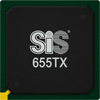Page 1: Intro, Board
<B>Intro</B>:
<center> </center>
</center>
This week is the time for the second installment of <a href="http://www.sis.com">SiS</a>' chipsets. The 655TX is an evolution of the 655FX (which is why it came out after!), improving on the memory to CPU design to increase performance. We saw last week that the 655FX can hold its own against similar Intel chipsets, but how does the TX fair? Let's get into it shall we...?
<B>Box</B>:
Reference board! No box... (I throw this section in as a filler because I can )
)
<B>How it works</B>:
<center> </center>
</center>
From the above picture, you can see that the TX is pretty much the same as the FX in connectivity. It offers the basic features such as the AGP 3.5 Spec, Dual DDR (up to 4GB), and the latest 800MHz HT Pentium 4 CPUs... even Prescott. Where the TX gets its strength is the new memory controller that speeds up transactions by faking a command...
<center> </center>
</center>
By combing the above into a one step process, the TX can offer improved memory latency. Whether or not this will be any benefit will be shown in the benchmarks, but it is interesting to see how they increased the performance. Consider this a tweak to an already good chipset.
<B>The Board</B>:
<center> </center>
</center>
We won't dive into the board too much because it is a reference board after all. I'll be securing some retail products soon and will have reviews of the production boards on this and other chipsets. As you can see above, it is the 655TX in all its glory.
<center> </center>
</center>
You can see the weirdness of the board present in the reference boards. You'll note the connections on the bottom as well as buttons for power on and reset on the board itself. Also notice the placement of the ATX power connector and all the various capacitors on near the AGP/PCI slot region. You should also direct you attention to the CPU area, which is pretty clear of capacitors, except for on the left side. This one supports 4 DDR modules (1 GB max per slot).
<center> </center>
</center>
The ports on this one are the same as the other one. And also like the last one, the NIC didn't work. I don't know if it was just a bad batch or what, but when it was replaced with a PCI NIC it worked fine. Don't tell me I'm doing something wrong either, I do this stuff for a living. Let's move on to the meat of the review.
<center>
 </center>
</center>This week is the time for the second installment of <a href="http://www.sis.com">SiS</a>' chipsets. The 655TX is an evolution of the 655FX (which is why it came out after!), improving on the memory to CPU design to increase performance. We saw last week that the 655FX can hold its own against similar Intel chipsets, but how does the TX fair? Let's get into it shall we...?
<B>Box</B>:
Reference board! No box... (I throw this section in as a filler because I can
 )
)<B>How it works</B>:
<center>
 </center>
</center>From the above picture, you can see that the TX is pretty much the same as the FX in connectivity. It offers the basic features such as the AGP 3.5 Spec, Dual DDR (up to 4GB), and the latest 800MHz HT Pentium 4 CPUs... even Prescott. Where the TX gets its strength is the new memory controller that speeds up transactions by faking a command...
<center>
 </center>
</center>By combing the above into a one step process, the TX can offer improved memory latency. Whether or not this will be any benefit will be shown in the benchmarks, but it is interesting to see how they increased the performance. Consider this a tweak to an already good chipset.
<B>The Board</B>:
<center>
 </center>
</center>We won't dive into the board too much because it is a reference board after all. I'll be securing some retail products soon and will have reviews of the production boards on this and other chipsets. As you can see above, it is the 655TX in all its glory.
<center>
 </center>
</center>You can see the weirdness of the board present in the reference boards. You'll note the connections on the bottom as well as buttons for power on and reset on the board itself. Also notice the placement of the ATX power connector and all the various capacitors on near the AGP/PCI slot region. You should also direct you attention to the CPU area, which is pretty clear of capacitors, except for on the left side. This one supports 4 DDR modules (1 GB max per slot).
<center>
 </center>
</center>The ports on this one are the same as the other one. And also like the last one, the NIC didn't work. I don't know if it was just a bad batch or what, but when it was replaced with a PCI NIC it worked fine. Don't tell me I'm doing something wrong either, I do this stuff for a living. Let's move on to the meat of the review.
